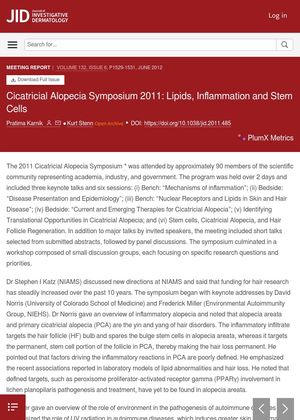Cicatricial Alopecia Symposium 2011: Lipids, Inflammation and Stem Cells
June 2012
in “Journal of Investigative Dermatology”

TLDR The symposium concluded that a specific lipid might cause hair loss, inflammation is a key factor, and stem cells in bald scalps aren't working right, suggesting new treatment targets.
The Cicatricial Alopecia Symposium in 2011, attended by approximately 90 scientists, focused on the roles of lipids, inflammation, and stem cells in hair loss. The symposium found that prostaglandin D2, a lipid, was present in higher levels in bald scalps, suggesting its role in hair loss. Inflammation was identified as a key factor in cicatricial alopecia, and anti-inflammatory treatments were suggested as potential management strategies. The symposium also found that while stem cells were present in bald scalps, they were not functioning properly, possibly due to inflammation or lipid changes. The potential of PPARγ and AhR as therapeutic targets was discussed, with 50% of lichen planopilaris patients responding to treatment with Pioglitazone, a PPARγ agonist. The symposium concluded with the need for better understanding of the role of lipids in hair loss and the role of the sebaceous gland in hair biology.
View this study on doi.org →